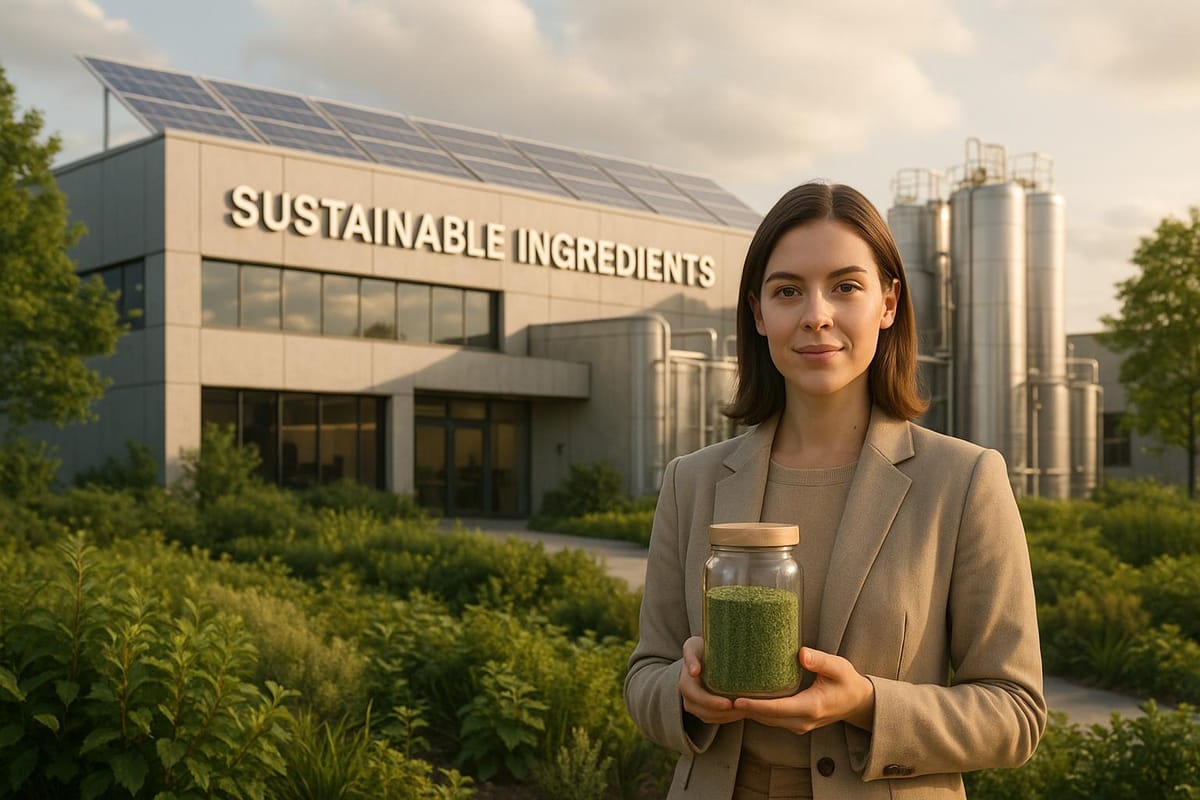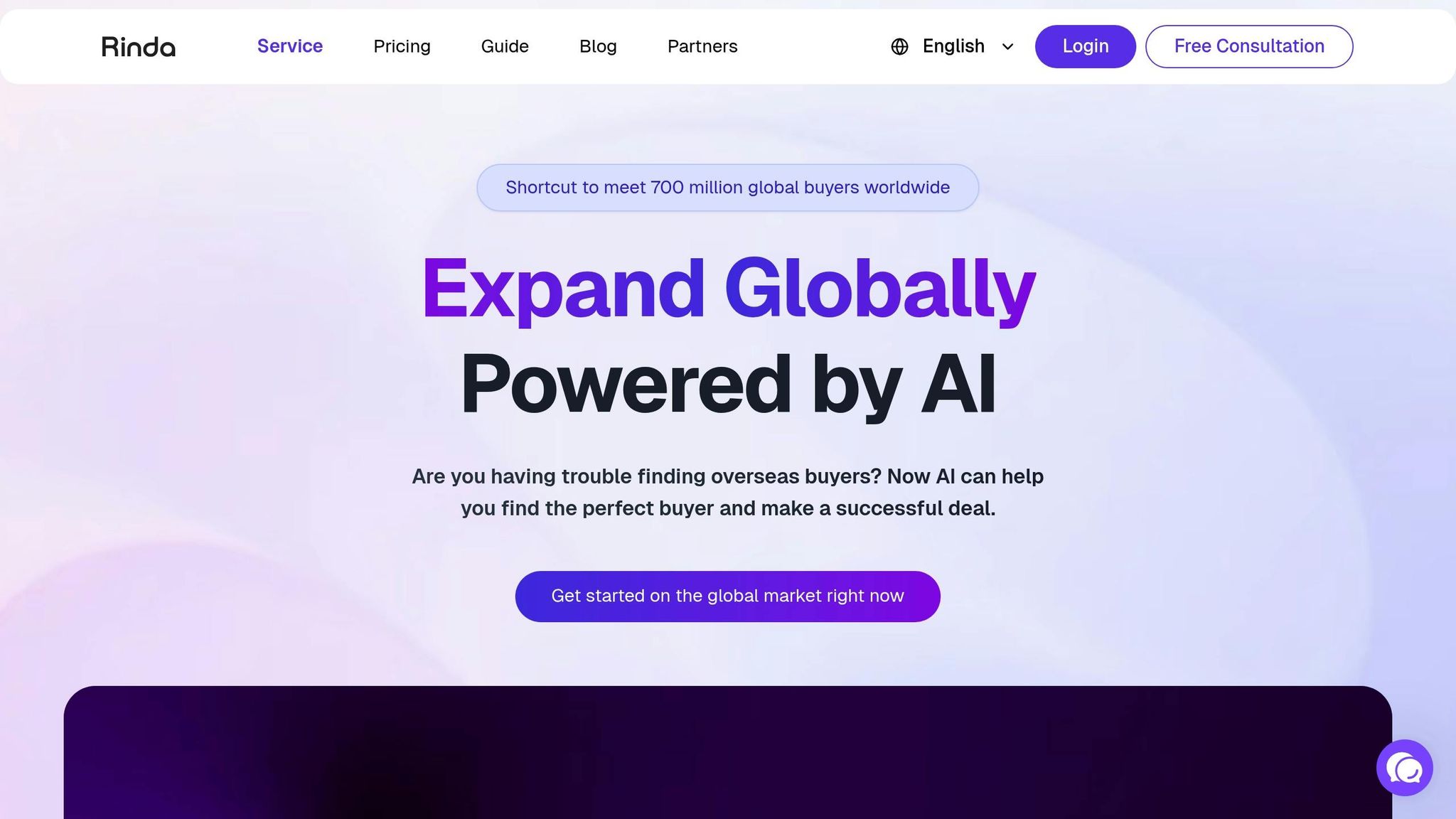Beauty Goes Green and Smart: $300M Sustainable Ingredients Plant Opens as 77% of Industry Embraces AI-Powered Personalization
Explore how AI and sustainability are reshaping the beauty industry, driving growth and innovation through personalized experiences and eco-friendly practices.

The beauty industry is transforming as two major forces reshape its future: eco-conscious product development and AI-driven personalization. 77% of beauty companies now rely on AI to tailor experiences, while global demand for eco-friendly ingredients propels investments like the $300 million Qore facility in Iowa. This plant, which produces 66,000 metric tons of bio-based 1,4-butanediol annually, slashes emissions by up to 93%, meeting rising consumer expectations for sustainable and personalized solutions.
In this article, you'll discover:
- How AI-powered personalization is driving a projected $16.4 billion market by 2033, improving customer satisfaction and loyalty.
- The rapid growth of sustainable beauty ingredients, with the clean beauty market expected to reach $39 billion by 2033.
- Key innovations like AI tools optimizing supply chains and ingredient sourcing, reducing costs and carbon footprints.
With consumer demand for transparency, ethical sourcing, and tailored products at an all-time high, businesses must align with these trends to stay competitive. Whether you're navigating stricter regulations or seeking to boost ROI through AI and sustainability, these insights provide actionable strategies.
Read on to learn how these shifts can position your business for growth in a changing market.
L'Oréal and IBM: AI Revolutionizing Sustainable Cosmetics
Sustainable Ingredients: Market Growth Drivers
The market for sustainable beauty ingredients is expanding at a striking pace, fueled by a mix of shifting consumer preferences, environmental concerns, and advancements in technology. In 2023, the clean beauty market was valued at $8.7 billion, and it is expected to climb to $39 billion by 2033, with a compound annual growth rate of 16.65%. This rapid growth underscores a major change in consumer values, as 69% of people now say sustainability has become more important to them in the past two years. This momentum is sparking new approaches to sustainable production.
Consumer behavior is a key driver behind this shift. More than 40% of shoppers prioritize natural ingredients in their beauty and personal care products, and 45% consider ethical sourcing one of the most important sustainability claims. These aren't just preferences - they reflect a deeper commitment to aligning purchases with personal ethics and environmental awareness.
Interestingly, skincare has emerged as the dominant category in the clean beauty market, capturing a 41.7% revenue share in 2023. This suggests that consumers are particularly mindful of the products they apply directly to their skin. Transparency is also a major factor, with 57% of consumers expressing interest in detailed information about sourcing and production processes. These trends are shaping how brands develop and market their products.
New Developments in Sustainable Beauty Ingredients
The beauty industry is embracing innovations that meet both sustainability goals and performance demands. A standout example came in July 2025 when Qore, a joint venture between Cargill and HELM AG, launched production of its Qira brand 1,4-butanediol (BDO) at a $300 million facility in Eddyville, Iowa. The site uses locally grown dent corn sourced within 100 miles, reflecting a commitment to regional and sustainable practices.
This facility is projected to produce 66,000 metric tons of Qira annually, reducing greenhouse gas emissions by up to 93% compared to traditional BDO manufacturing methods. Qira plays a crucial role in beauty products, as it is used to create polyvinylpyrrolidone (PVP), a water-soluble polymer commonly found in items like mascara and eyeliner.
Jon Veldhouse, CEO of Qore, highlighted the collaborative effort behind this innovation: "Qore is able to leverage the deep agricultural network and world-class fermentation technology expertise from Cargill and Helm's global market reach to bring Qira to life".
This example underscores the importance of partnerships that combine diverse areas of expertise to advance sustainable ingredient development.
Significant investments are also being made by major players in the market. The natural ingredients segment in cosmetics is forecast to grow from $642 million in 2022 to $1,095 million by 2030. Companies like BASF SE are expanding their offerings with products such as Verdessence RiceTouch, an ingredient upcycled from non-GMO rice and certified by COSMOS and NATRUE.
Challenges and Benefits of Sustainable Ingredient Adoption
Despite the clear market potential, transitioning to sustainable ingredients comes with hurdles. Higher costs, extended timelines, material shortages, and misinformation from suppliers are some of the biggest challenges companies face. For instance, using bio-resin plastic or post-consumer recycled (PCR) packaging can increase costs by 10% to 30% compared to traditional virgin plastic.
Beyond financial pressures, brands also face technical difficulties when replacing synthetic ingredients with eco-friendly alternatives. These substitutes must meet high standards for performance, safety, and shelf life, which often requires significant research and development investments and can delay product launches.
Still, the advantages of adopting sustainable ingredients are undeniable.
Jill Zullo, Vice President of Biointermediates/Bioindustrial at Cargill, noted: "With consumers demanding more sustainable products, brands are not only looking for more innovative, environmentally-friendly solutions but also are needing supplier capabilities and resources that can consistently meet those expectations".
Regulations are also accelerating the shift. Stricter standards are pushing manufacturers toward greener practices, while consumers are increasingly avoiding products with harmful chemicals like parabens and sulfates. Millennials and Gen Z are leading the charge, favoring eco-conscious formulations and setting the tone for the future of clean beauty.
The intersection of consumer demand, regulatory changes, and technological advancements is reshaping the market for sustainable ingredients. Brands that invest in ethical sourcing and transparent communication are well-positioned to attract environmentally conscious consumers, who are quickly becoming the driving force behind purchasing decisions in the beauty industry. This evolution in ingredient sourcing also lays the groundwork for future innovations that could redefine how consumers interact with beauty products.
AI-Powered Personalization: Changing Consumer Experiences
The beauty industry is embracing AI to create personalized experiences, stepping away from the traditional one-size-fits-all approach to meet the growing demand for products tailored to individual needs and preferences. By leveraging advanced analytics, brands are unlocking new ways to connect with consumers.
In 2023, the AI-driven beauty market was valued at $3.27 billion and is expected to grow to $8.1 billion by 2028, with an impressive compound annual growth rate of 20.1%. Some estimates go even further, predicting the market could reach $16.4 billion by 2033. This rapid growth highlights the industry's recognition of AI-powered personalization as a key to staying competitive.
Consumer behavior data further supports this trend. A striking 77% of consumers either chose or were willing to pay more for brands offering personalized experiences. Additionally, 36% of customers reported greater satisfaction with hyper-personalization, and 47% expressed increased loyalty to brands delivering tailored solutions. These numbers underscore the growing importance of personalization in building strong consumer relationships.
At the heart of this shift are advanced machine learning and computer vision technologies that make these personalized experiences possible.
Key AI Technologies in Beauty Personalization
AI technologies are transforming the way beauty brands understand and cater to their customers. Machine learning analyzes skin data to uncover patterns in skin types, concerns, and product preferences, while computer vision enables real-time assessments of facial features and skin conditions.
For instance, Perfect Corp's AI skin diagnostic tool analyzes three facial images - front, left, and right profiles - to perform a detailed skin analysis, identifying issues like acne and wrinkles. This approach ensures comprehensive coverage, including tricky areas like the chin and cheeks. Similarly, Revieve's patented algorithms assess over 200 facial and skin health metrics, offering precise insights into individual needs.
Another standout example is Olay's Skin Advisor platform, which uses AI to predict skin age with 90% accuracy, leading to a 200% increase in conversion rates. This level of precision bridges the gap between consumer expectations and product recommendations, fostering trust.
AI is also driving innovation in product development. YSL Beauty's Rouge Sur Mesure device uses AI to create custom lipstick shades by combining real-time environmental data with personal preferences. Meanwhile, Proven Skincare employs its "The Skin Genome Project" AI engine to analyze over 20,000 ingredients, 100,000 products, and 25 million consumer reviews, delivering highly tailored skincare solutions.
These technologies are setting a strong foundation for broader adoption across the beauty industry.
AI Personalization Adoption Across the Industry
AI-powered personalization is quickly becoming a standard practice in the beauty sector. According to McKinsey, AI tools are expected to influence up to 70% of customer interactions in the industry by 2027. This shift reflects the growing reliance on technology to enhance customer engagement.
The benefits for businesses are clear. Companies excelling in personalization generate 40% more revenue compared to competitors, and 91% of consumers are more likely to shop with brands offering relevant recommendations. It's no surprise, then, that 86% of industry leaders view personalization as a critical element of their customer experience strategies.
Beyond revenue, personalization also drives operational efficiency. Brands implementing personalization programs can reduce customer acquisition costs by up to 50%. Moreover, fast-growing companies report 40% more revenue from personalization compared to slower-moving competitors.
"We want to disrupt the category, driving differentiation and, in turn, incremental growth. Industry-leading operational excellence, using AI digital solutions to grow our business, is a core pillar of Unilever's Growth Action Plan", says Zoe Eungblut, Beauty & Wellbeing Digital Strategy Director.
Satisfied customers amplify these benefits. After positive experiences, customers spend up to 140% more than those with negative interactions and are three times more likely to recommend brands to others. This creates a feedback loop where AI-driven personalization not only enhances direct sales but also fuels organic growth through word-of-mouth.
The financial potential is significant. A study by Accenture suggests that AI-powered personalization could boost beauty sales by up to 30%. As brands increasingly focus on sustainability in ingredient sourcing, AI-driven personalization complements these efforts by delivering tailored products that align with consumer values.
"AI has the potential to revolutionize product development by accelerating the research process and uncovering new ingredient combinations that were previously overlooked", explains Guive Balooch, head of L'Oréal's Technology Incubator.
Case Study: RINDA's AI-Driven Global Sales Automation

In the beauty industry, where sustainable growth and international expansion are key challenges, RINDA's AI-powered global sales platform emerges as a pivotal solution. This platform not only simplifies global operations but also supports the industry's shift toward eco-conscious strategies. By automating sales processes, RINDA enables beauty brands to expand their reach while aligning with sustainable goals. This case study highlights how RINDA integrates cutting-edge AI technology with the industry's evolving priorities, showcasing its role in transforming global beauty sales.
Key Features of RINDA's Platform
RINDA's platform is designed to simplify and enhance international sales efforts. It automates the process of identifying overseas buyers and supports communication in over 20 languages, eliminating the need for time-intensive manual research. Additionally, it ensures accurate communication of product certifications, a critical factor in global trade. Using advanced algorithms, the platform matches potential customers with the specific capabilities of beauty brands, streamlining the buyer discovery process.
Beyond this, RINDA includes tools for real-time buyer interest verification and automatic credibility checks, helping brands avoid fraudulent inquiries and focus on genuine opportunities. This automation not only saves time but also allows companies to redirect their efforts toward innovation and sustainability.
Supporting Sustainable Growth with Automation
RINDA's automation tools are designed to drive efficiency while promoting sustainable practices. By handling the complexities of international sales, the platform frees up resources that can be reinvested into product development and eco-friendly initiatives. Its data analysis features enable brands to refine their global strategies, reducing resource waste and improving productivity across sales teams.
This streamlined approach minimizes the need for excessive travel and physical marketing efforts, contributing to a more sustainable operational model. Continuous data insights further enhance sales strategies, boosting conversion rates and ensuring competitiveness in global markets. For beauty brands prioritizing sustainable ingredients and tailored solutions, RINDA provides a strategic edge, aligning operational efficiency with environmental goals. This synergy positions companies for long-term success in an increasingly global and eco-conscious marketplace.
Future Outlook: Sustainability and AI in the Beauty Industry
The beauty industry is undergoing a remarkable transformation as AI technologies and sustainability take center stage. With consumer preferences evolving and technology advancing, the sector is poised for significant changes. By 2031, the sustainable beauty market is expected to hit $326.8 billion, while 77% of beauty professionals see conversational AI agents as a game-changer for personalization. This dual momentum offers brands exciting opportunities to innovate while addressing environmental concerns.
At the same time, stricter environmental regulations and increasing transparency requirements are forcing companies to reevaluate their operations. For instance, 67.7% of Gen Z consumers prioritize sustainability, and over half (56.2%) are willing to pay a premium for eco-friendly beauty products. These trends are pushing brands to merge AI-driven personalization with genuine commitments to sustainability, creating a new standard for the industry.
Eco-Development and AI Trends to Watch
The intersection of AI and sustainability is leading to groundbreaking advancements in the beauty industry. Emerging technologies are reshaping how brands approach everything from product design to supply chain management. For example, AI-driven supply chain innovations could reduce carbon emissions in the beauty sector by up to 15% by 2030. Additionally, algorithms designed for packaging optimization are already cutting material waste by as much as 35%.
One standout initiative is L'Oréal's collaboration with IBM, launched in January 2025, which leverages generative AI to develop sustainable formulations. This technology accelerates research and identifies new ingredient combinations, revolutionizing product development processes.
AI is also enabling closed-loop ingredient systems, where machine learning identifies sustainable alternatives, predicts their performance, and optimizes formulations for both efficacy and environmental impact. Companies using AI-powered carbon accounting tools, such as SAP's platform, report average carbon footprint reductions of 25%, with up to 95% accuracy in tracking Scope 3 emissions.
Supply chain transparency is another area where AI is making a tangible impact. For instance, Cosnova used Makersite to map its entire supply chain in just two days, creating a solid foundation for monitoring and improving sustainability efforts. This level of visibility enables real-time optimization and helps address bottlenecks quickly.
Preparing for the Next Decade of Beauty
Looking ahead, beauty brands will need to navigate a complex landscape of shifting consumer expectations and tighter regulations. By 2030, online sales are projected to account for nearly one-third of global beauty purchases, even as 54% of executives cite uncertain consumer spending as a significant risk. Despite these challenges, the global beauty market is expected to grow by 5% annually through the end of the decade.
Regulations are becoming increasingly rigorous, requiring transparency in ingredient sourcing, carbon footprint disclosures, and supply chain accountability. Companies that adopt AI-driven compliance systems early stand to gain a competitive advantage. As Neil D'Souza, CEO and Founder of Makersite, points out:
"With over 90% of a cosmetic product's environmental impact determined by design and the materials it's made from, the only way for personal care and cosmetics companies to address sustainability is to change how products are made".
These trends underline the growing importance of aligning sustainability efforts with personalized solutions. The customized skincare market, valued at $29.3 billion in 2024, is projected to more than double to $62.4 billion by 2034. At the same time, 32% of consumers are opting for high-quality, affordable alternatives, emphasizing the need for efficiency through AI-driven automation. Together, these shifts will shape the beauty industry's future, blending innovation with a commitment to environmental responsibility.
FAQs
How is AI transforming the beauty industry with personalized products and better customer experiences?
AI is transforming the beauty industry by helping brands design personalized products that cater to individual needs. By evaluating factors such as skin type, personal preferences, and even local environmental conditions, AI enables the creation of skincare and makeup products that are better suited to each customer’s unique requirements.
Moreover, tools powered by AI, like virtual try-ons and customized consultations, give customers the chance to explore products and receive tailored advice before making a purchase. This not only boosts confidence in their choices but also encourages satisfaction and loyalty. On top of that, it plays a role in reducing waste and product returns, as customers are more likely to select items that align with their specific needs.
What challenges do beauty brands face when switching to sustainable ingredients, and how can they address them?
Switching to more sustainable ingredients brings a unique set of challenges for beauty brands. These include higher production costs, limited availability of environmentally friendly materials, varying regulatory requirements, and consumer skepticism. Together, these issues create a complex balancing act between achieving sustainability goals, maintaining profitability, and meeting customer expectations.
Brands looking to navigate these challenges can explore innovative sourcing strategies. This might involve collaborating with ethical suppliers or leveraging biotechnology to develop sustainable ingredient alternatives. Incorporating eco-conscious packaging and emphasizing transparency in sourcing and production practices can also help build credibility and trust among consumers. Moreover, by educating customers on the advantages of sustainable beauty products, companies can address misconceptions and encourage more thoughtful purchasing decisions.
How does the $300 million Qore facility help reduce carbon emissions in the beauty industry?
The $300 million Qore facility is reshaping the beauty industry by introducing bio-based ingredients like QIRA. Using plant-based sugars and fermentation, this method replaces conventional oil-based materials, dramatically cutting down greenhouse gas emissions.
The impact is striking - bio-derived products from the facility can lower greenhouse gas emissions by as much as 93% compared to traditional methods. This shift not only reduces the industry's carbon footprint but also aligns with efforts to adopt more eco-conscious practices.
